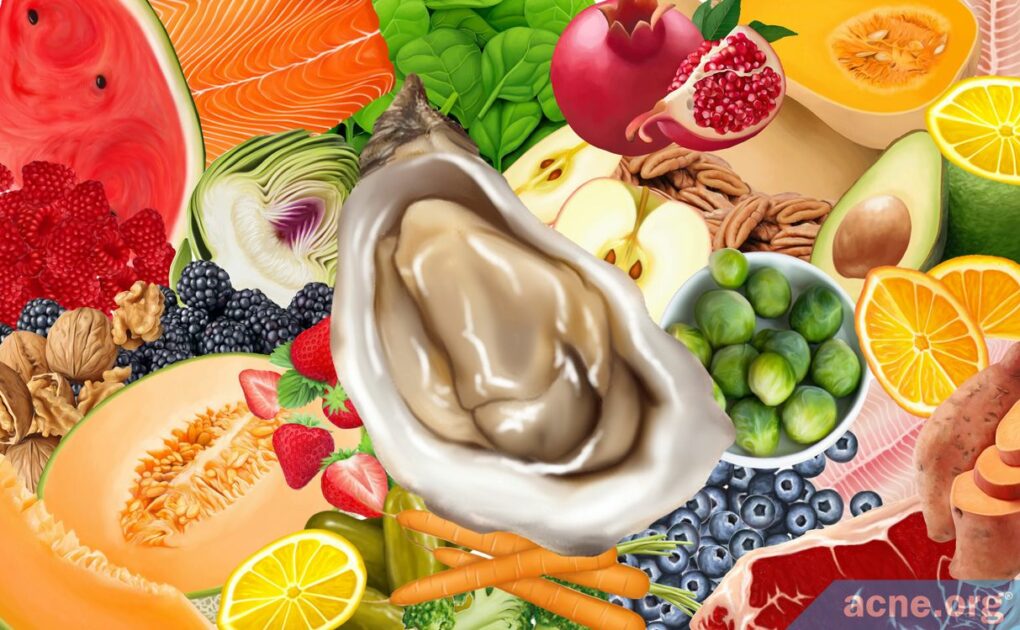Low-Glycemic Foods, as Well as Foods High in Antioxidants, Zinc, and Omega-3s Might Help. The Top Food: Oysters!

The Essential Info
No one knows for sure to what degree diet affects acne. However, we do have some initial evidence that points towards the possibility that certain foods might be better for acne than others. The foods that are likely best for acne include:
- Wild-caught Fish – Wild-caught (not farmed) fish is high in omega-3 fats that may help reduce the inflammation of acne as well as help heal the skin.
- Whole Vegetables and Fruits – Colorful vegetables and fruits are high in antioxidants, and this may help reduce the inflammation of acne.
And if there were one food that we could say is the best, it would be…drumroll please…
- Oysters – Oysters have far more zinc than any other food (zinc deficiency has been shown to be correlated with acne) and are also high in omega-3 fats. Just 2 or 3 of them pack a wallop when it comes to zinc.

The Science
The dermatological community still does not know whether diet impacts acne, and if so, to what extent. However, some initial studies have shown that certain foods might possibly be better for acne than others. These foods include:
- Low-glycemic foods – Foods that only raise blood sugar to a small degree
- High-antioxidant foods – Colorful veggies and fruits
- Foods high in zinc – This is where oysters stand out
- Foods rich in omega-3 fats – Wild-caught fish
The good news is that, besides potentially helping with acne, these foods are beneficial for health in general. Among other things, they may help the skin to stay youthful longer, so it can’t hurt to incorporate them in your diet as much as is realistically possible.1
Low Glycemic Foods
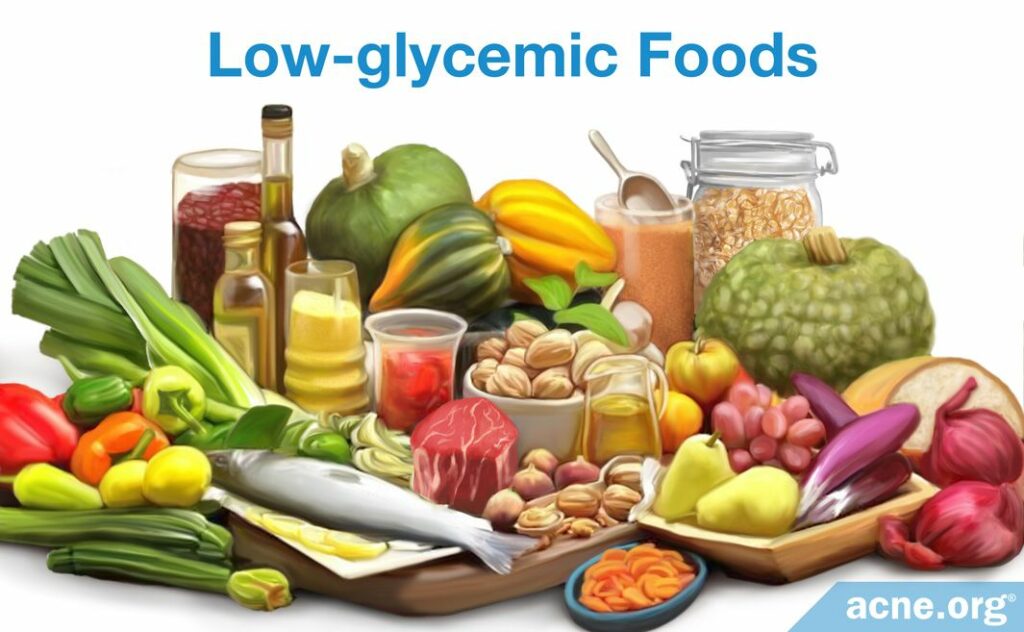
The glycemic load is a measurement scientists use to determine whether a food will cause an increase in the amount of sugar in your blood. High-glycemic load foods cause a lot of sugar in the blood, while low-glycemic load foods cause a small amount of sugar in the blood.
Scientists that have studied the glycemic load and acne have found that people who eat a lot of high-glycemic load foods may develop more acne. However, these studies only examined a small number of people, and used surveys, which are considered an imperfect tool, so more research is needed to confirm this finding.2 But, if it is indeed true that high-glycemic load foods lead to more acne, then it is likely that low-glycemic load foods are preferred.
Some examples of low glycemic load foods that are possibly good for acne include:
- Whole vegetables
- Whole fruits (especially berries)
- Nuts and nut butters
- Beans/legumes
- Eggs
- Meat & fish
- Eggs
- Oils
Foods High in Antioxidants
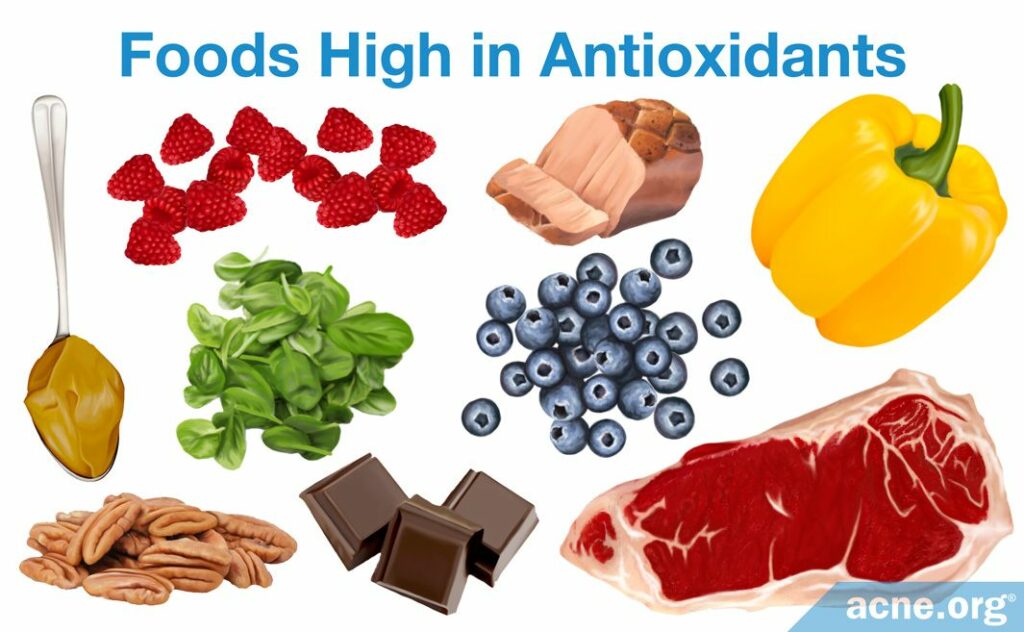
Antioxidants are vitamins and minerals that protect the body from inflammation by preventing toxic chemicals, called reactive oxygen species (ROS), from forming in the body. By preventing the formation of ROS, antioxidants can lower inflammation. Since acne is an inflammatory disease, reducing inflammation might help reduce acne symptoms.
In addition, research suggests that people with acne tend to be deficient in certain antioxidants, such as vitamin A, vitamin E, and selenium.3 This means that foods high in antioxidants might possibly be good for acne because they may correct an antioxidant deficiency and help to reduce inflammation.4
Obtaining these antioxidants from food is preferable to taking large amounts of supplements. Because the body can store vitamins A and E, taking supplements of these vitamins can allow them to build up to toxic levels in your body, whereas it is essentially impossible to overdose on vitamins from food.
Foods high in antioxidants include:
- Whole vegetables
- Whole fruits
- Nuts and nut butters
- Certain meats like beef and chicken liver
It’s important to keep in mind that cooking or frying can greatly reduce the antioxidant content of food. Therefore, it’s best to eat antioxidant-rich foods fresh or lightly cooked if possible.5
Foods High in Zinc
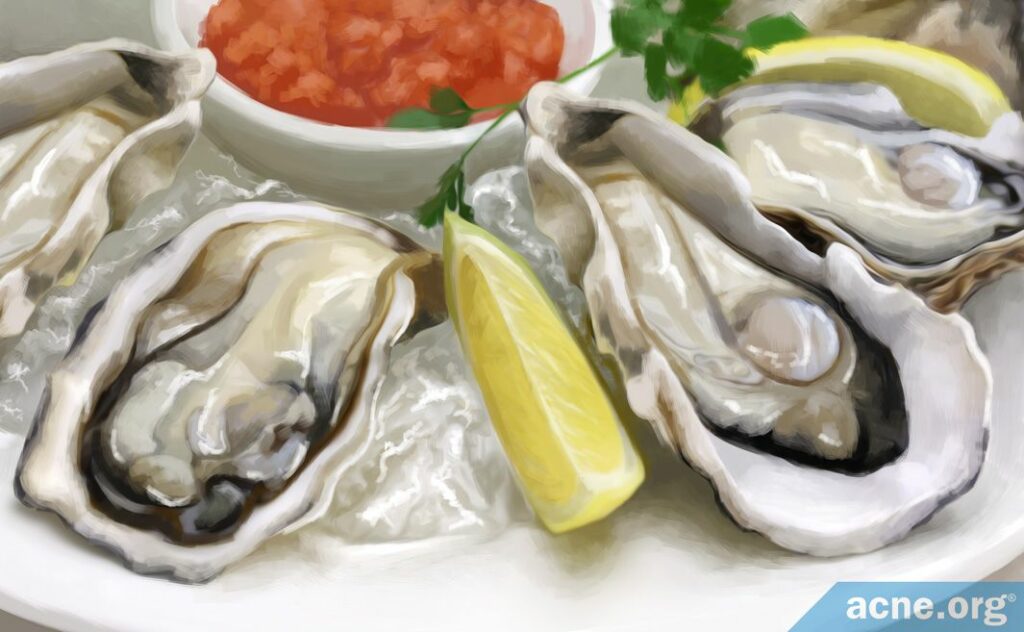
Zinc is a mineral that is essential for human health. In terms of acne, zinc has a positive effect on acne, and both topical and oral medications containing zinc can somewhat improve acne. Researchers believe that zinc works to reduce acne in three ways:
- Reducing inflammation
- Killing off acne bacteria
- Decreasing androgen hormones, which are acne-associated hormones found in both men and women
Since zinc might have a positive effect on acne, it is possible that eating foods high in zinc may also lead to a decrease in acne.6
Oysters contain much more zinc than any other food. In fact, eating 3 ounces of oysters (6 medium-size oysters) contains 493% of the recommended daily allowance of zinc.
But, oysters aren’t the only foods that contain zinc. Other zinc-containing foods include beef and crab, but they contain a much smaller amount of zinc compared to oysters. So, if you want to eat foods that contain the highest amount of zinc, oysters are the way to go!
Foods High in Omega-3s fats
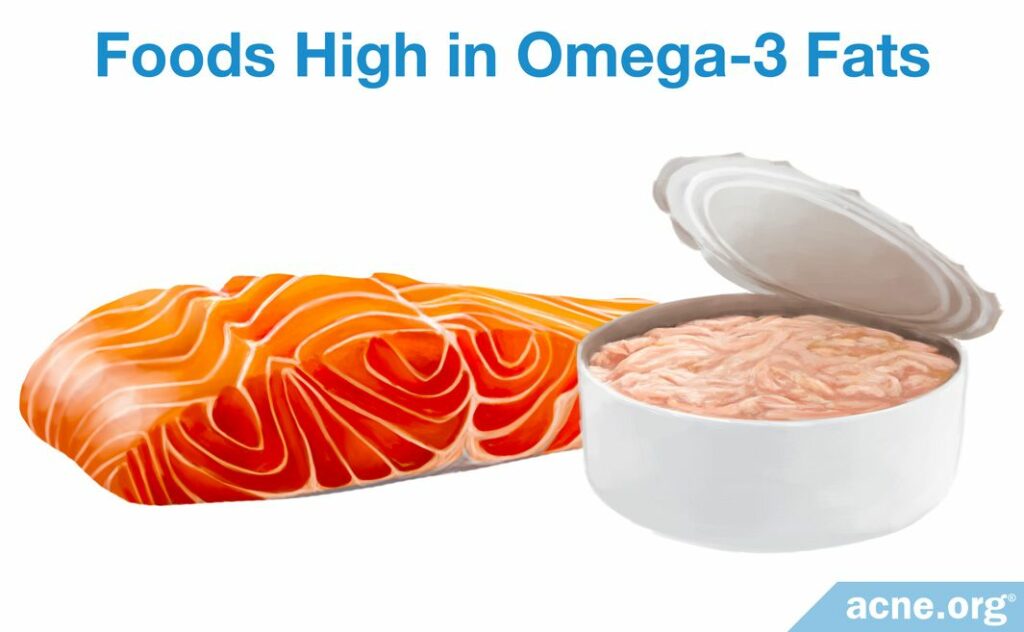
Omega-3s are a special type of fat called a polyunsaturated fatty acid (PUFA). PUFAs have several important functions in the body, but when it comes to acne, PUFAs are important because they can lower inflammation. Specifically, PUFAs decrease the body’s production of a substance called leukotriene B4, which triggers inflammation in the earliest stage of acne.7 Since acne is an inflammatory disease, anything that can lower inflammation might also possibly help to decrease acne. Omega-3s decrease inflammation, hence it is possible that eating more omega-3s might possibly help improve acne.8,9
The main source of omega-3s is fish. The fish with the highest amount of omega-3s include:
- Atlantic herring
- Atlantic salmon
- Sardines
- Rainbow trout
- Mackerel
- Halibut
- Tuna
- Oysters
However, eating fish every day is usually not feasible for most people. This is where fish oil pills come in. Fish oil pills contain a high amount of omega-3s, so taking up to 6 fish oil pills per day (or up to 3 “concentrated” fish oil pills) will help increase the amount of omega-3s in your diet.
Takeaway
While we still cannot say conclusively that a particular type of diet causes acne, evidence suggests that eating certain foods may help with acne to some degree.10
When it comes to acne, just like with other diseases, not surprisingly it is best to “eat healthy.” That means eating lots of colorful vegetables, some colorful fruits, and filling your diet with low glycemic foods like fish, nuts, eggs, and beans. It also means cutting down on high glycemic foods like sugar, soda, white bread, and processed food. Don’t stress yourself out about your diet too much, but try to eat healthy when you can, and just for fun, add in some oysters whenever you can for an extra dose of zinc.
References
- Smith, R. N., Mann, N. J., Braue, A., Makelainen, H. & Varigos, G. A. A low-glycemic-load diet improves symptoms in acne vulgaris patients: A randomized controlled trial. American Journal of Clinical Nutrition 86, 107-115 (2007). https://www.ncbi.nlm.nih.gov/pubmed/17616769
- Briganti, S. & Picardo, M. Antioxidant activity, lipid peroxidation and skin diseases. What’s new. J Eur Acad Dermatol Venereol 17, 663 – 669 (2003). https://www.ncbi.nlm.nih.gov/pubmed/14761133
- Gupta, M., Mahajan, V. K., Mehta, K. S. & Chauhan, P. S. Zinc therapy in dermatology: a review. Dermatol. Res. Pract. 2014, 1 – 11 (2014). https://www.ncbi.nlm.nih.gov/pubmed/25120566
- Rubin, M. G., Kim, K., & Logan, A. C. Acne vulgaris, mental health and omega-3 fatty acids: a report of cases. Lipids in Health and Disease 7, 36 (2008). https://www.ncbi.nlm.nih.gov/pubmed/18851733
- Pasiakos, S.M., et al. Appetite and endocrine regulators of energy balance after 2 days of energy restriction: insulin, leptine, ghrelin, and DHEA-S. Obesity 19, 1124-1130 (2011). https://www.ncbi.nlm.nih.gov/pubmed/21212768
- Gupta, M., Mahajan, V. K., Mehta, K. S. & Chauhan, P. S. Zinc therapy in dermatology: a review. Dermatol Res Pract 2014, 1 – 11 (2014). https://www.ncbi.nlm.nih.gov/pubmed/25120566
- Sardana, K. & Sachdeva, S. Role of nutritional supplements in selected dermatological disorders: A review. Journal of Cosmetic Dermatology 21, 85-98 (2022). https://pubmed.ncbi.nlm.nih.gov/34564936/
- Rubin, M.G., Kim, K. & Logan, A.C. Acne vulgaris, mental health and omega-3 fatty acids: a report of cases. Lipids in Health and Disease 7, 36 (2008). https://www.ncbi.nlm.nih.gov/pubmed/18851733
- Pasiakos, S.M., et al. Appetite and endocrine regulators of energy balance after 2 days of energy restriction: insulin, leptine, ghrelin, and DHEA-S. Obesity 19, 1124-1130 (2011). https://www.ncbi.nlm.nih.gov/pubmed/21212768
- Burris, J., et al. Acne: the role of medical nutrition therapy. Journal of the Academy of Nutrition and Dietetics 113, 416-430 (2013). https://pubmed.ncbi.nlm.nih.gov/23438493/
 Acne.org Products
Acne.org Products